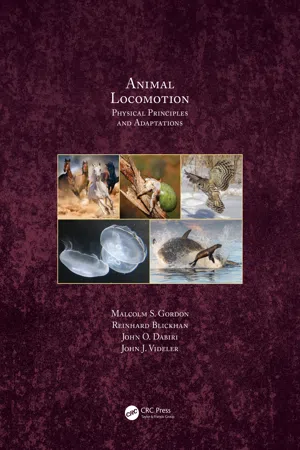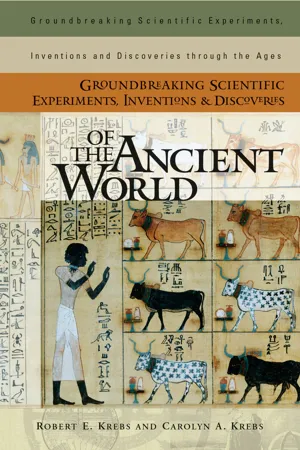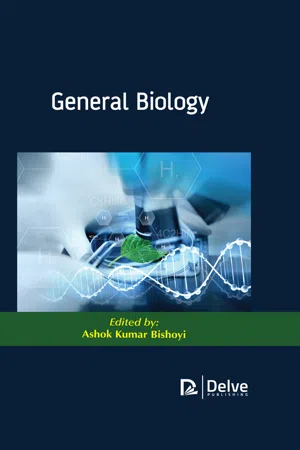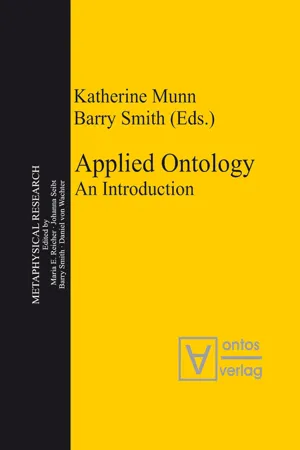Biological Sciences
Animals
Animals are multicellular, eukaryotic organisms that form the kingdom Animalia. They are characterized by their ability to move, consume organic material for energy, and reproduce sexually. Animals display a wide range of adaptations for survival in diverse environments, and they play crucial roles in ecosystems as consumers, prey, and predators.
Written by Perlego with AI-assistance
Related key terms
1 of 5
6 Key excerpts on "Animals"
- eBook - PDF
Animal Locomotion
Physical Principles and Adaptations
- Malcolm S. Gordon, Reinhard Blickhan, John O. Dabiri, John J. Videler(Authors)
- 2017(Publication Date)
- CRC Press(Publisher)
(2015). The materials, designs, and structures that sup-port and organize the physical–chemical processes and systems in Animals have historically been included in biophysics, biomaterials, anatomy, and functional morphology (Wainwright and Reilly 1994; Liem et al. 2001; Vincent 2012; Schilling and Long 2014). Animals working as integrated physical systems are the subject matter of bio-mechanics (statics and kinematics; Currey 2006; Leondes 2007a, 2007b, 2009) and bioengineering (Chien et al. 2008). Relationships between struc-ture and function are central themes of study. Each of these fields can also be approached in multiple ways just outlined for physiology (i.e., compara-tive, environmental, ecological). The advent in more recent years of molecular biological and molecular genetic technologies, theories, and methods has added multiple new dimensions to these classical fields. The aspects most relevant to the concerns of these books have become to significant extents parts of what is now called systems biology (Dubitzky et al. 2013). Systems biology includes the various fields of omics such as genomics, epigenetics, proteomics, physiomics, and metabolomics. The evolution-ary and phylogenetic histories and relationships of animal groups, and also the processes involved in their morphological development and growth, are two important subject areas that are in process 4 ANIMAL LOCOMOTION of being radically changed by the advent of sys-tems biological knowledge. 1.6 ADDITIONAL CONSIDERATIONS 1.6.1 More about the Fossil Record Careful studies of the fossil record permit multiple insights and inferences relating to the events and processes that have produced the designs, organi-zations, and structures of living Animals. Chapter 2 describes in greater detail the fossil record and many of its properties. Some features of the record that strongly influence and often limit understand-ing were mentioned in Section 1.2. - Robert E. Krebs, Carolyn A. Krebs(Authors)
- 2003(Publication Date)
- Greenwood(Publisher)
3 BIOLOGY, BOTANY, A N D ZOOLOGY Background and History As defined in modern-day terminology, biology is that branch of the natural sciences that studies living organisms and systems (cellular and acellular). It encompasses several specialized areas of living organisms, such as cytology (the study of cells), zoology (the study of Animals), botany (the study of plants), and ecology (the study of environmental systems). Although ecology will not be discussed in this chapter, it is important to understand what ecology is. Ecology is the scientific study of the interrelationships of organisms and their physical, chemical, and biological environments. It is a study of systems. As a science, it draws on many other disciplines, such as physics, chemistry, geology, climatology, oceanography, economics, and mathematics. Ecology is often confused with environmentalism; the latter is often considered a political move- ment rather than a science. However, the term "biology" actually originated about 1802 with Jean Baptiste Monet, Chevalier de Lamarck (1744-1829), when he was devel- oping his theories of evolution. The fact that biology, as a body of sci- ence, was not identified until the beginning of the nineteenth century does not mean that biology, as a body of knowledge, was unknown. Quite the contrary, since the beginning of time, humans have been "practicing biologists." The roots of agriculture and animal domestica- tion were planted millions of years ago with the recognition that both plants and Animals were part of the natural cycle of life that could be bred, cultivated, and propagated. It is reasonable to assume that, by trial and error, ancient humans selected a variety of plants that sustained nourishment without adverse affects. In other words, they knew which plants they could and could not eat safely. They knew where certain- eBook - PDF
- Ashok Kumar Bishoyi(Author)
- 2020(Publication Date)
- Delve Publishing(Publisher)
FUNDAMENTALS OF BIOLOGY 1 CONTENTS 1.1 Introduction ......................................................................................... 2 1.2 Characteristics Of Life .......................................................................... 3 1.3 Levels Of Organization Of Living Things .............................................. 8 1.4 Diversity Of Life ................................................................................ 11 1.5 Branches Of The Biological Study ...................................................... 15 1.6 Process Of Science ............................................................................ 18 1.7 Nature Of Science ............................................................................. 19 1.8 Basic And The Applied Science .......................................................... 25 1.9 Reporting Scientific Work .................................................................. 27 References ............................................................................................... 28 General Biology 2 1.1 INTRODUCTION Seen from space, Earth is shown in Figure 1.1, provides few hints about the variety of life forms that reside there. The first kinds of life on the earth are believed to have been microorganisms which existed for around billions of years before Animals and plants appeared (Weier et al., 1970; Barbieri, 2003). The mammals, flowers, and birds which are so familiar are all comparatively recent, originating around 130 to 2 hundred million years ago. Humans have occupied the planet Earth from the last 2.5 million years, and in the last 200 thousand years humans have started looking like we all look today (Sumich & Morrissey, 2004; Kaneko, 2006; Boogerd et al., 2007). Figure 1.1. The NASA image is the composite of numerous satellite-based sights of Earth. To make the image of complete Earth, NASA scientists syndi-cate observations of the different parts of the planet. - eBook - PDF
Science and Math Bookmark Book
300 Fascinating, Fact-Filled Bookmarks
- Roni Berg, Kendall Haven(Authors)
- 1999(Publication Date)
- Libraries Unlimited(Publisher)
Ufe Sciences Life Sciences 66 What are the life and what do they study? Biology: behavior, growth, and structure of iving organisms. Medical Science: functions of the human body and tissue. Ecology: living communities. Anthropology: the origins, development, and distribution of humans. Paleontology: the fossil remains of past )lant and ""ssv Some common guesses? Plants can't move. Right? Wrong. Ocean plankton can and some Animals (coral and sponges) can't Plants can't communicate. Right? Wrong. Many plants communicate chemically with each other. So what is the difference? Animals take all their nutrients from the environ- ment Plants can manufac- ture some of their own nutrients. Animals grow uniformly in all parts of their body. Only certain parts of a plant grow at any given time. It doesn't seem like mock* kilt it's enough to classify things as either plant or animal. * * Answer: Into Kingdoms. THERE ARE 5 KINGDOMS- Plant, Animal, Fungi, and two just for single-cell organisms. V I R U S E S arent included in any of these kingdoms because we aren't sure if they are alive. S O N E believe viruses are the simplest of all living things. Some believe they are too simple to be called "alive." Opinion varies. They are in their own class, but it isn't rated as a kingdom. From The Science and Math Bookmark Book. © 1999 Kendall Haven and Roni Berg. Teacher Ideas Press. 1-800-237-6124 From The Science and Math Bookmark Book. © 1999 Kendall Haven and Roni Berg. Teacher Ideas Press. 1-800-237-6124 From The Science and Math Bookmark Book. © 1999 Kendall Haven and Roni Berg. Teacher Ideas Press. 1-800-237-6124 sciences, HOW DO WE GROUP LIVING THINGS? a n i m a l life Life Sciences 67 KINDS OF THINGS ARE IN THE? ANIMAL^Il KINGDOM?! Mammal Insect Spider Worm Crustacean Amphibian Reptile Fish Bird From The Science and Math Bookmark Book. © 1999 Kendall Haven and Roni Berg. Teacher Ideas Press. - eBook - PDF
Using the Biological Literature
A Practical Guide, Fourth Edition
- Diane Schmidt(Author)
- 2014(Publication Date)
- CRC Press(Publisher)
177 CHAPTER 9 Ecology, Evolution, and Animal Behavior This chapter covers materials for the allied fields of ecology, evolution, and ani-mal behavior. Ecology is “the study of the interrelationships between organisms and their natural environment, both living and nonliving.” Conservation biology and environmentalism are closely related but not extensively covered in this chapter. Evolution is “the gradual process by which the present diversity of plant and ani-mal life arose from the earliest and most primitive organisms.” See also Chapter 7, “Genetics, Biotechnology, and Developmental Biology” for related materials. Animal behavior, “the activities that constitute an animal’s response to its external environment,” ( Oxford Dictionary of Biology , 4th ed., 2000) here encompasses all biological subdisciplines including ethology, sociobiology, and behavioral ecology. Human behavior and comparative psychology are largely excluded from consider-ation, and neurobiology is covered in Chapter 11, “Anatomy and Physiology”. ABSTRACTS AND INDEXES Animal Behavior Abstracts. 1982–. Bethesda, MD: Cambridge Scientific Abstracts. Monthly. Price varies. ISSN 0301-8695. Covers all aspects of animal behavior, including psychological as well as bio-logical studies. Also available as part of the Biological Sciences database online (see Chapter 4). Current Advances in Ecological and Environmental Sciences. v. 15–, 1989–. Amster-dam, Netherlands: Elsevier. Monthly. $232.00. ISSN 0955-6648. Covers over 2000 periodicals of interest to ecologists, arranged by subject. Also has cross-references and author index. Available in print and online as part of Current Awareness in Biological Sciences ( CABS ) (see Chapter 4). Formerly: Current Advances in Ecological Sciences . Ecological Abstracts. v. 1–, 1974–. Amsterdam, Netherlands: Elsevier. Monthly. - eBook - PDF
- Katherine Munn, Barry Smith(Authors)
- 2013(Publication Date)
- De Gruyter(Publisher)
It can cause a great deal of trouble to maintain and update a system containing redundant information. For instance when new information concerning all insects comes to light, data would need to be changed in almost a million different places in the same way. But if the information is stored only in one place, namely under the label Insecta , such a change is easily made in one step. Though the classification of kinds into higher order kinds has such a practical purpose, it must not be arbitrary. Indeed, the best classification will always be one that refers to features that are, in fact, typical for the respective range of living beings. The class of mammals is a group of items that belong together in more than one respect, whereas the introduction of a class of two-legged Animals would soon cause trouble (since it would include birds and humans alike). Which divisions are appropriate can only be seen by simultaneously pursuing the downward movement of division and the upward movement of unification. 3. Biological Species We will now argue that a system for classifying living beings must be based on a division into biological species. This gives rise to the question of what a biological species is. This section will provide an answer to this question. In a logical sense, every group that may be divided into subgroups is a genus, and every group that may be brought under a higher order group is a species (Kant uses the terms in this sense in the second passage quoted above). The biologist, however, uses ‘species’ in a much narrower sense. Biological species constitute only one level within biological taxonomy. Below the level of biological species, one may distinguish populations, varieties, races, and forms; but these distinctions are always, to some extent, arbitrary in that they involve merely geographical and phenomenal differences. The taxa above the species level differ from species in that they are only associated with a fragmentary or ambiguous description.
Index pages curate the most relevant extracts from our library of academic textbooks. They’ve been created using an in-house natural language model (NLM), each adding context and meaning to key research topics.





